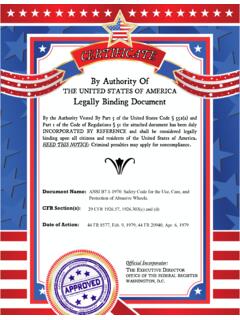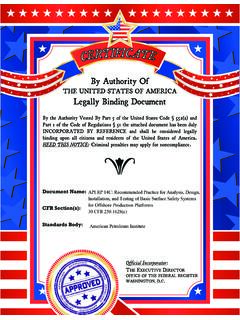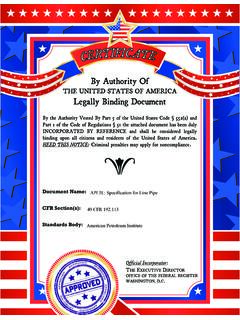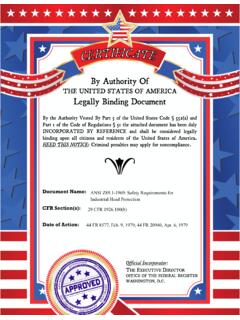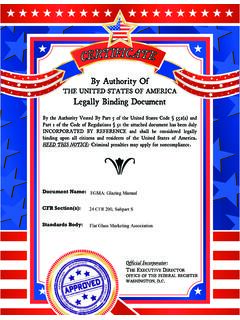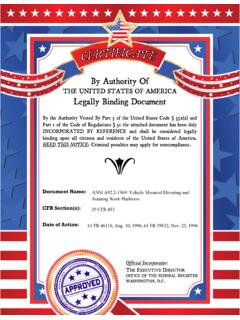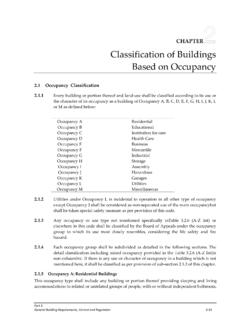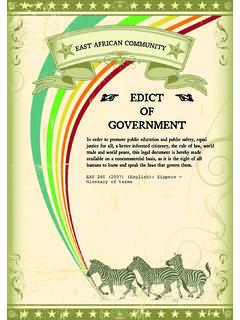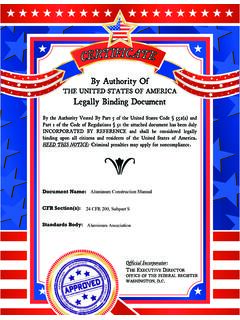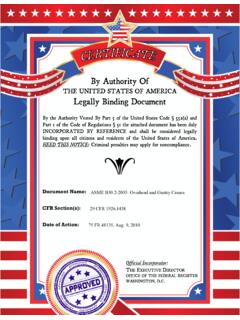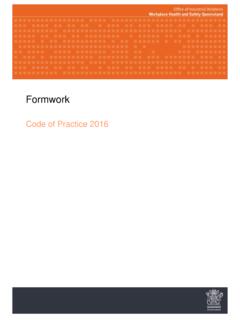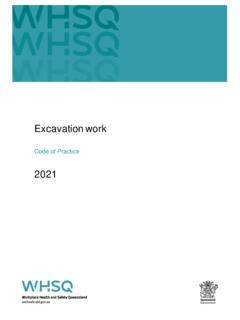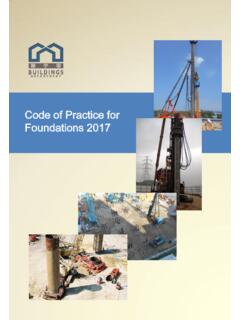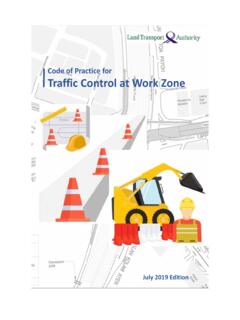Transcription of IS 12288 (1987): Code of Practice for Use and Laying of ...
1 Disclosure to Promote the Right To InformationWhereas the Parliament of India has set out to provide a practical regime of right to information for citizens to secure access to information under the control of public authorities, in order to promote transparency and accountability in the working of every public authority, and whereas the attached publication of the Bureau of Indian Standards is of particular interest to the public, particularly disadvantaged communities and those engaged in the pursuit of education and knowledge, the attached public safety standard is made available to promote the timely dissemination of this information in an accurate manner to the public.
2 ! $ ' + - Satyanarayan Gangaram Pitroda Invent a New India Using Knowledge 0 1 ' 5 Jawaharlal Nehru Step Out From the Old to the New 1 + , 1 + Mazdoor Kisan Shakti Sangathan The Right to Information, The Right to Live ! > 0 B Bhart hari N ti atakam Knowledge is such a treasure which cannot be stolen Invent a New India Using Knowledge IS 12288 (1987): code of Practice for Use and Laying ofDuctile Iron Pipes [CED 24: Public Health Engineering.] IS : 12288 - 1987 I code Indian Standard OFPRACTICEFOR USEANDLAYINGOFDUCTILEIRONPIPES 0.
3 FOREWORD This Indian Standard was adopted by the Bureau of Indian Standards on 30 December 1987, after the draft finalized by the Water Supply and Sanitation in Buildings Sectional Committee had beed approved by the Civil Engi- neering Division Council. The Laying of pipelines for water supply and drainage has been generally governed by the guidelines laid down by various municipalities and local authorities. However, at present there are no guidelines for Laying of ductile iron pipes which have been used in India recently at some places. This code is intended to give guidelines for proper Laying of ductile iron pipes.
4 For the purpose of deciding whether a parti- cular requirment of this standard is complied with, the final values, observed or calculated, ex- pressing the result of a test or analysis, shall be rounded off in accordance with IS : 2-1960*. The number of significant places retained in the rounded off value should be the same as that of the specified value in this standard. *Rules for rounding off numerical values ( revised ). 1. SCOPE This code covers the methods of Laying cen- trifugally cast (spun) ductile iron pressure pipes of diameters 80 mm and above, laid either above ground or below ground for water supply and drainage.
5 It also includes handling and jointing of pipes, hydrostatic testing, commissioning of laid pipes, back filling, restoration and mainte- nance of surfaces. For the purpose of this code , ductile iron pressure pipes and the fittings shall conform to IS : 8329-1977 . 2. ROUTING General - The choice of route for a pipeline is governed by economic considerations and other factors such as overhead and underground cables, existing pipelines and traffic flow. For cross country terrain before carrying out final field survey, the pipe alignment shall be marked on Survey of India maps and reconnai- sance should be undertaken along the pipe route selected.
6 Any change called for should be made before the final survey is undertaken. Final Field Survey Plans - Field surveys for strip width representing about 500 m along the proposed alignments should be carried out. Any vertical section or profile along the pipeline route should be shown to a scale appropriate to the variations in ground elevation. Special crossings which require permission from authority should *Specification for centrifugally cast ( spun ) ductile iron pressure pipes for water, gas and sewage. 1 be detailed on separate drawings and cross referenced to the appropriate strip plan; the scale should be between 1 : 100 and 1 : 125 de- pending on the complexity of the work.
7 In built up areas, consideration should be given to the use of plans of 1 : 1250 scale. In urban areas, trail trenches at suitable intervals will be necessary to locate the utilities which may affect the Laying of pipes. 3. SITE PREPARATION Preliminary work required to be done before Laying of pipelines includes pegging out, clearing and disposal of all shrubs, grasses, large and small bushes, trees, hedges, fences, gates, portions of old masonry, boulders, and debris from the route. Where trees have been felled, the resulting timber shall be stacked properly and disposed of as directed by the authority.
8 Tree roots within a distance of about 05 metre from either side of the pipeline should be completely removed before Laying pipelines. All other serviceable materials, such as wood, bricks and stones, recovered during the operation of clearing the site, shall be separately stacked and disposed of as directed by the authority. 4. FORMATION General pipeline is laid, proper formation shall be prepared for pipeline. Excavation and Preparation of Trenches for Laying Underground Pipeline IS : 12288 - 1987 The width of the trench at bottom between the faces of sheeting shall be such as to provide not less than 200 mm clearance on either side of the pipe except where rock excavation is involved.
9 Trenches shall be of such extra width, when required, as will permit the convenient placing of timber supports, strutting and planking, and hand- ling of specials. Special consideration should be given to the depth of the trench. In agriculturalland, the depth should be sufficient to provide a cover of not less than 900 mm so that the pipeline will not interfere with the cultivation of the land. In rocky ground, rough grazing or swamps, the cover may be reduced provided the water in the pipeline is not likely to freeze due to frost. It may be necessary to increase the depth of pipeline to avoid land drains or in the vicinity of roads, railways or other crossings.
10 Care should be taken to avoid the spoil bank causing an accumulation of rainwater. Where pipes are to be bedded directly on the bottom of the trench (See Fig. IA), it should be trimmed and levelled to permit even bedding of the pipeline and should be free from all extra- neous matter which may damage the pipe or the pipe coating. Additional excavation should be made at the joints of the pipes so that the water main is supported along its entire length. Where excavation is through rocks or boulders, the pipeline should be bedded on concrete bedding ( see Fig. 1B ) or on at least 150 mm of fine grained material ( see Fig.)
